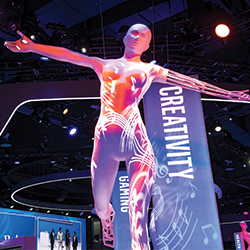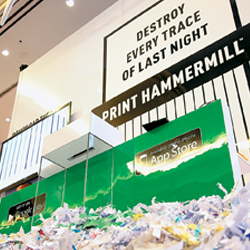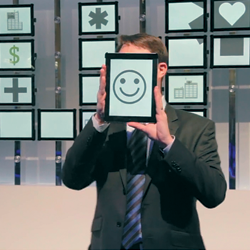sizzle awards |
 |
 |
INTEGRATED PROGRAM |
Exhibitor: MG Design Associates Corp.
Creative/Production:
MG Design Associates Corp., Pleasant Prairie, WI, 262-947-8890, www.mgdesign.com
Production: Stamm Media Inc.,
Milwaukee,
414-263-4200,
www.stammmedia.com
Show: EXHIBITOR2011
Budget: $216,900
Goals:
 Secure four RFPs. Secure four RFPs.
 Garner at least three press mentions in industry publications. Garner at least three press mentions in industry publications.
 Increase the company's number of social-media followers. Increase the company's number of social-media followers.
 Lure 30 VIP prospects and clients to the "Mansion of Mystery" for meetings. Lure 30 VIP prospects and clients to the "Mansion of Mystery" for meetings.
Results:
 Received six RFPs to date, with more in the works. Received six RFPs to date, with more in the works.
  Generated six press mentions. Generated six press mentions.
 Doubled the company's number of Twitter followers. Doubled the company's number of Twitter followers.
 Met with 30 VIP prospects and clients during the show. Met with 30 VIP prospects and clients during the show. |
 |
 rofessor Plum, in the library, with the candlestick." Believe it or not, those eight words were the inspiration for MG Design Associates Corp.'s integrated program at EXHIBITOR2011, an educational conference and exhibition for exhibit and event marketers held at Mandalay Bay Convention Center in Las Vegas. Of course, most people associate the phrase with the classic board game, "Clue," which is set inside a nine-room mansion. The object of that popular game is to solve a murder using the powers of deduction. Players each select one of six characters to represent themselves and pitch suggestions throughout the game, proposing a suspect, a location, and a murder weapon by which the crime took place. rofessor Plum, in the library, with the candlestick." Believe it or not, those eight words were the inspiration for MG Design Associates Corp.'s integrated program at EXHIBITOR2011, an educational conference and exhibition for exhibit and event marketers held at Mandalay Bay Convention Center in Las Vegas. Of course, most people associate the phrase with the classic board game, "Clue," which is set inside a nine-room mansion. The object of that popular game is to solve a murder using the powers of deduction. Players each select one of six characters to represent themselves and pitch suggestions throughout the game, proposing a suspect, a location, and a murder weapon by which the crime took place.
MG Design, a Pleasant Prairie, WI-based exhibit firm, set out to solve a slightly less macabre - but no less intriguing - mystery for EXHIBITOR2011 attendees: how to incorporate various technologies, such as social media, radio-frequency identification (RFID), quick-response (QR) codes, and augmented reality, into an exhibit-marketing campaign. "Technology is becoming more and more popular in the exhibit industry, yet so many people still don't understand exactly how it can be incorporated," says Ben Olson, director of marketing for MG Design. "They also don't realize the level of intelligence and data that technologies like RFID can provide post show."
Thus, the company hoped to solve that conundrum with an integrated program, the focal point of which would be an interactive exhibit experience dubbed "MG Design's Mansion of Mystery." "Our goal was to take the mystery out of exhibit intelligence," Olson says. "We wanted to allow attendees the opportunity to experience these technologies firsthand in practical applications that they could use in their own exhibits." Olson figured that by demystifying the technology through real-world, exhibit-centric applications, he could educate attendees and position MG Design as the go-to exhibit company for said applications.
Marketing Modus Operandi
The Mansion of Mystery would remain a mystery to attendees unless MG Design could get them to visit the exhibit. So the company devised a pre-show marketing strategy that would hit the three audience segments it targeted at EXHIBITOR2011: exhibit managers, members of the press, and VIP clients and prospects. The first segment, preregistered exhibit managers, received an e-blast approximately two weeks prior to the show. Introducing the Mansion of Mystery theme, the e-blast featured an image of a butler holding a silver tray, on which a small white card with the word "clue" appeared. An accompanying headline read: "MG Design takes the mystery out of creating powerful trade show experiences." Additional text invited recipients to "follow the clues to booth #1837 at EXHIBITOR2011 and MG Design's Mansion of Mystery where an adventure in integrated design and technology awaits you." The e-blast also featured a gray fingerprint behind MG Design's logo, under which was the tagline, "Mystery Solved."
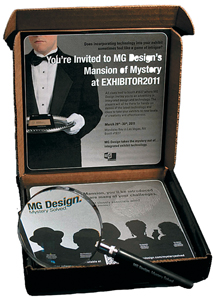 Roughly two weeks later (and just days before the exhibit hall opened), MG Design sent another e-blast to the same group of attendees. This time, instead of a butler, the graphic featured the blacked-out silhouettes of five different people (later to be revealed as The Colonel, The Socialite, The Actress, The Heiress, and The Professor). A headline above the lineup read: "Can you hear the EXHIBITOR buzz building now? The Clues all point to MG Design! At EXHIBITOR2011, be sure to visit MG Design's Mansion of Mystery. Located in booth 1837, the Mansion will feature a hands-on technology experience that will help take the mystery out of integrated exhibit technology. You'll also be introduced to a cast of characters who share many of the same trade show issues that you do." Roughly two weeks later (and just days before the exhibit hall opened), MG Design sent another e-blast to the same group of attendees. This time, instead of a butler, the graphic featured the blacked-out silhouettes of five different people (later to be revealed as The Colonel, The Socialite, The Actress, The Heiress, and The Professor). A headline above the lineup read: "Can you hear the EXHIBITOR buzz building now? The Clues all point to MG Design! At EXHIBITOR2011, be sure to visit MG Design's Mansion of Mystery. Located in booth 1837, the Mansion will feature a hands-on technology experience that will help take the mystery out of integrated exhibit technology. You'll also be introduced to a cast of characters who share many of the same trade show issues that you do."
Believing that the promise of tech tutelage, coupled with the opportunity to meet the veiled characters, would be enough to entice even the most discerning attendee, MG Design turned its attention to its next target - the press. Hoping to create enough buzz to garner a few media mentions prior to the show, MG Design issued a series of press releases to industry publications. Each of the releases contained a QR code that linked to a show-specific site: www.mgdesign.com/exhibitor2011. Alluding to the pre-show e-blasts, the site's landing page featured a gray fingerprint graphic behind the text, "MG Design. Mystery Solved." Visitors found additional press releases about MG Design as well as links to the company's Twitter, LinkedIn, YouTube, and Vimeo pages, each packed with Mansion of Mystery-related content.
In addition to the e-blasts and press releases, MG Design had one more pre-show trick up its sleeve - a dimensional mailer. The company sent a black cardboard box to each of its 50 targeted VIPs (clients selected based on company name, job title, industry, and scope of their trade show programs). The box featured the same gray fingerprint graphic from the e-blasts on the mailing label and the text, "Important Clue Inside." Upon opening the box, VIPs discovered hard copies of each of the pre-show e-blasts inviting them to visit the exhibit, as well as a magnifying glass printed with the company's logo and tagline, "Mystery Solved."
By now, all three audience segments were familiar with MG Design's Mansion of Mystery, its intent to demystify technology through an in-booth experience, and the existence of an unidentified "cast of characters." But to uncover more clues, including the identities of the five characters, they'd have to visit exhibit 1837.
Prime Suspects
While the Mansion of Mystery was inspired by "Clue," its cast of characters didn't comprise potential murder suspects. The five, silhouetted characters featured on the second pre-show mailer were actually representative of MG Design's own customers and their respective needs - profiles based on data gathered via an in-booth survey conducted in the company's booth at EXHIBITOR2010.
So to spread the word about the Mansion of Mystery and to reveal the identity of MG Design's characters, staffers left dozens of baseball-card-sized calling cards throughout Mandalay Bay and handed out the cards when they interacted with attendees throughout the show.
Each card represented one of the five characters. Featuring MG Design's booth number and the character's name and photo on one side, the flip side contained character-specific text. For example, The Colonel's card read: "When you need to rally your troops, here's your clue to basic training. MG Design takes the mystery out of getting the most from your trade show staff!" While The Colonel represented staff-training needs, the other four characters
- The Socialite, The Actress, The Professor, and The Heiress - represented experiential needs, design needs, measurement needs, and budget needs, respectively. The intent of the cards was to drive traffic to the Mansion of Mystery, where attendees would discover which character best represented their own exhibit-marketing needs.
House of Cards
When the show floor opened and curious attendees finally sleuthed their way to booth 1837, they encountered the now-infamous Mansion of Mystery - a 20-by-30-foot exhibit with a profile reminiscent of a Le Corbusier design. Indeed, the exterior walls - two pairs of 8-by-8-foot laminate-sheathed panels topped with a roof-like peak to create a stylized home environment - possessed an understated elegance. Washed in white and bearing minimal copy and graphics, the structure again reiterated the campaign's theme, which was supported by the phrase, "Take the mystery out of Exhibits. Environments. Events. Experiences." The exhibit's strikingly modest exterior was sharply contrasted by its lavishly appointed interior, complete with a rich color palette and mansion-appropriate accessories such as an elegant chandelier, tapestry, a fireplace, wood flooring, and dark leather furniture.
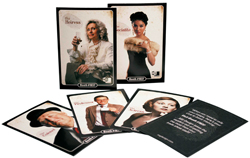 But before attendees could make themselves at home, they had to first speak with the lord of the manor - in this case, a docent positioned at a small wooden counter-height island located on one side of the mansion. The docent
(an MG Design staffer dressed in black) greeted attendees as they approached the mansion's threshold. Based on information gathered through a series of qualifying questions, attendees were assigned one of the five characters and given a corresponding character card. Similar to the calling cards left behind by MG Design staffers, the roughly 5.5-by-8-inch card featured the character's name and exhibit need. However, the character cards also contained a key message related to that need. For example, The Professor's exhibit need was measurement, so accompanying text read: "As a professor, it's critical to measure my efforts so I'm able to prove my theories. MG Design builds assessment metrics into trade show programs, ensuring you receive the right data, in the right format, at the right time." But before attendees could make themselves at home, they had to first speak with the lord of the manor - in this case, a docent positioned at a small wooden counter-height island located on one side of the mansion. The docent
(an MG Design staffer dressed in black) greeted attendees as they approached the mansion's threshold. Based on information gathered through a series of qualifying questions, attendees were assigned one of the five characters and given a corresponding character card. Similar to the calling cards left behind by MG Design staffers, the roughly 5.5-by-8-inch card featured the character's name and exhibit need. However, the character cards also contained a key message related to that need. For example, The Professor's exhibit need was measurement, so accompanying text read: "As a professor, it's critical to measure my efforts so I'm able to prove my theories. MG Design builds assessment metrics into trade show programs, ensuring you receive the right data, in the right format, at the right time."
Tools for three of the technologies that MG Design set out to demystify were embedded into each card: an RFID chip, a QR code, and an augmented-reality marker. Furthermore, each character card was synched to each attendee's badge, so MG Design could track attendee-specific data related to the in-booth experience. Upon receiving a character card, each guest was paired with an exhibit staffer, who served as a tour guide through the Mansion of Mystery's four rooms: The Study, The Library, The Conservatory, and The Kitchen.
 The Study. Illuminated by a faux fire (a video loop of a fire displayed on a flatscreen monitor imbedded in a fake-stone hearth), The Study was appointed with a leather chair, a patterned area rug, an old-fashioned pendulum clock, and a replica 1920s-era rotary phone. Here, visitors stepped up to the hearth and placed their character card on an RFID sensor near the phone on the mantle. Soon, the phone rang, and the voice of the character depicted on the card was heard through wall-mounted speakers.
For example, if The Actress' card was placed on the
sensor, she relayed the
following message via a wall speaker: "Hello there, this is The Actress. MG Design tells me that you're also concerned with looks. Me too. Looks are everything in my profession.
No matter how brilliant you are on the inside, without the right exterior, you'll never get noticed by the big studios." After the narrative concluded, a clue appeared on a monitor mounted above the fireplace. In The Actress' case, the clue read, "Great design begins with intelligence." The clue was followed by a brief video displaying examples of MG Design's work accompanied by a design-specific narrative, completing the experience. The Study. Illuminated by a faux fire (a video loop of a fire displayed on a flatscreen monitor imbedded in a fake-stone hearth), The Study was appointed with a leather chair, a patterned area rug, an old-fashioned pendulum clock, and a replica 1920s-era rotary phone. Here, visitors stepped up to the hearth and placed their character card on an RFID sensor near the phone on the mantle. Soon, the phone rang, and the voice of the character depicted on the card was heard through wall-mounted speakers.
For example, if The Actress' card was placed on the
sensor, she relayed the
following message via a wall speaker: "Hello there, this is The Actress. MG Design tells me that you're also concerned with looks. Me too. Looks are everything in my profession.
No matter how brilliant you are on the inside, without the right exterior, you'll never get noticed by the big studios." After the narrative concluded, a clue appeared on a monitor mounted above the fireplace. In The Actress' case, the clue read, "Great design begins with intelligence." The clue was followed by a brief video displaying examples of MG Design's work accompanied by a design-specific narrative, completing the experience.
 The Library. The attendee next entered The Library, an area defined by a parquet floor, a wooden counter with cabinets, a bookshelf lined with books, and a 40-inch flatscreen monitor mounted to a back wall. Additional accessories included a chandelier hanging from the ceiling, a substantial-looking book atop a bookstand, and a globe resting on a pedestal. The tour guide invited the attendee to step up to the cabinet and place his or her character card face up on the counter, directly below the monitor. The card then prompted the monitor to switch from what it was displaying to a message from the character. The Library. The attendee next entered The Library, an area defined by a parquet floor, a wooden counter with cabinets, a bookshelf lined with books, and a 40-inch flatscreen monitor mounted to a back wall. Additional accessories included a chandelier hanging from the ceiling, a substantial-looking book atop a bookstand, and a globe resting on a pedestal. The tour guide invited the attendee to step up to the cabinet and place his or her character card face up on the counter, directly below the monitor. The card then prompted the monitor to switch from what it was displaying to a message from the character.
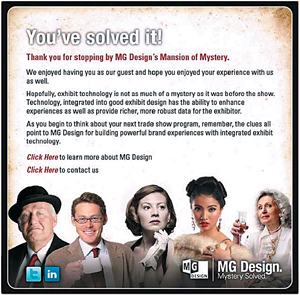 This time, the character directed the attendee to look inside a red book resting on the shelf next to the monitor. The book housed an iPad 2, which was used to scan the QR codes located on several other books sitting on the shelves. Each time an attendee scanned a book's QR code, one of five technology-related YouTube videos popped up on the iPad. While the attendee viewed the content, the tour guide explained how QR codes can be used in an exhibit to link to websites hosting product demonstrations, specs, photos, etc., thus eliminating the need to ship physical products and literature to the show floor. Again, the interaction concluded with a clue displayed on the flatscreen: "The world is your oyster!" This time, the character directed the attendee to look inside a red book resting on the shelf next to the monitor. The book housed an iPad 2, which was used to scan the QR codes located on several other books sitting on the shelves. Each time an attendee scanned a book's QR code, one of five technology-related YouTube videos popped up on the iPad. While the attendee viewed the content, the tour guide explained how QR codes can be used in an exhibit to link to websites hosting product demonstrations, specs, photos, etc., thus eliminating the need to ship physical products and literature to the show floor. Again, the interaction concluded with a clue displayed on the flatscreen: "The world is your oyster!"
 The Conservatory. The tour guide led the attendee to The Conservatory, an area of the mansion featuring a backlit wall displaying an image of a landscaped garden and lush green lawn. The guide then instructed the attendee to place his or her character card face up on an RFID sensor embedded in a faux-stone countertop. As soon as the card was placed, the character's voice was heard once again. The Actress, for example, said, "Oh, there you are. I'm outdoors rehearsing. Enjoy The Conservatory and your final clues to solve your trade show mysteries." The third clue appeared on a monitor embedded in the center of the back wall, "Technology opens the doors to design opportunities," followed by a short video explaining how technology can be used to enhance exhibit design. The Conservatory. The tour guide led the attendee to The Conservatory, an area of the mansion featuring a backlit wall displaying an image of a landscaped garden and lush green lawn. The guide then instructed the attendee to place his or her character card face up on an RFID sensor embedded in a faux-stone countertop. As soon as the card was placed, the character's voice was heard once again. The Actress, for example, said, "Oh, there you are. I'm outdoors rehearsing. Enjoy The Conservatory and your final clues to solve your trade show mysteries." The third clue appeared on a monitor embedded in the center of the back wall, "Technology opens the doors to design opportunities," followed by a short video explaining how technology can be used to enhance exhibit design.
After the video ended, a webcam hidden inside a plastic sunflower (which was connected to the monitor), switched on, displaying a mirror image of the attendee and tour guide. The attendee then took his or her character card and held it (with the augmented-reality marker on the card facing up) in front of the webcam. Like magic, a 3-D rendering of the Mansion of Mystery appeared on the monitor, looking as if it had materialized on the card itself. Attendees manipulated the image on the monitor by slightly rotating the card, allowing them to see the mansion from various angles. While attendees explored the 3-D model, the tour guide explained how augmented reality could be used to create virtual animations, exploded views, and 3-D models of heavy, cumbersome equipment.
 The Kitchen. The last stop on the Mansion of Mystery tour, The Kitchen featured black-and-white checkered flooring, various canisters and jars lining the butcher-block countertops, a pot rack hanging from the ceiling, and three 40-inch flatscreen monitors embedded in the doors of white kitchen cabinets. Here, an attendee stepped up to an island counter and placed his or her character card on a white plate, which was equipped with an RFID sensor. A nearby touchscreen displayed a personalized welcome message for the attendee, inviting him or her to take a short survey about social media. Multiple-choice questions included "What areas do you see the potential for technology to improve your program?" and "What social media platforms do you currently use for business purposes?" The final question on the survey prompted attendees to post a comment about their visit to the Mansion of Mystery via MG Design's Twitter feed. The Kitchen. The last stop on the Mansion of Mystery tour, The Kitchen featured black-and-white checkered flooring, various canisters and jars lining the butcher-block countertops, a pot rack hanging from the ceiling, and three 40-inch flatscreen monitors embedded in the doors of white kitchen cabinets. Here, an attendee stepped up to an island counter and placed his or her character card on a white plate, which was equipped with an RFID sensor. A nearby touchscreen displayed a personalized welcome message for the attendee, inviting him or her to take a short survey about social media. Multiple-choice questions included "What areas do you see the potential for technology to improve your program?" and "What social media platforms do you currently use for business purposes?" The final question on the survey prompted attendees to post a comment about their visit to the Mansion of Mystery via MG Design's Twitter feed.
Upon completing the survey, a message appeared on the touchscreen thanking the attendee for participating, along with a button labeled "Solve" (after all, what's a mystery worth if you can't solve it?). Touching the button revealed the answer to the question, "How do I incorporate various technologies into an exhibit-marketing campaign?" The solution, which appeared in "Clue" format, was: "MG Design, on the trade show floor, with integrated design and technology."
|
 The Study: The first stop on the tour, The Study demonstrated how RFID technology can be used to create a personalized exhibit experience. After placing the character card on the mantle, a phone rang and that character relayed a message to the attendee.
The Study: The first stop on the tour, The Study demonstrated how RFID technology can be used to create a personalized exhibit experience. After placing the character card on the mantle, a phone rang and that character relayed a message to the attendee. |
 The Library: Here, attendees were prompted by a character message to open a red book, retrieve an iPad 2, and scan the QR codes found on several books sitting on the shelves. The QR codes linked to MG Design content, demonstrating how the technology can be used to link to exhibitors' own websites, videos, product catalogs, etc. The Library: Here, attendees were prompted by a character message to open a red book, retrieve an iPad 2, and scan the QR codes found on several books sitting on the shelves. The QR codes linked to MG Design content, demonstrating how the technology can be used to link to exhibitors' own websites, videos, product catalogs, etc. |
 The Conservatory:
MG Design reps invited attendees to take their card and place it in front of a webcam (hidden inside a plastic sunflower). The augmented-reality marker on the card activated, causing a 3-D model of the Mansion of Mystery
to appear on the flatscreen. This activity showed attendees how augmented reality can be used for 3-D models of products, exploded views, and the like. The Conservatory:
MG Design reps invited attendees to take their card and place it in front of a webcam (hidden inside a plastic sunflower). The augmented-reality marker on the card activated, causing a 3-D model of the Mansion of Mystery
to appear on the flatscreen. This activity showed attendees how augmented reality can be used for 3-D models of products, exploded views, and the like. |
 The Kitchen: The final stop on the tour, The Kitchen revealed nuggets of information gathered via RFID about each attendee's visit to the Mansion of Mystery. Three large flatscreen monitors mounted to the kitchen's cabinetry featured stats regarding the amount of time each attendee spent in each room, as well as aggregate data about all the visitors that toured the mansion. MG Design reps explained how RFID can help exhibit managers collect data about attendees at their own shows. The Kitchen: The final stop on the tour, The Kitchen revealed nuggets of information gathered via RFID about each attendee's visit to the Mansion of Mystery. Three large flatscreen monitors mounted to the kitchen's cabinetry featured stats regarding the amount of time each attendee spent in each room, as well as aggregate data about all the visitors that toured the mansion. MG Design reps explained how RFID can help exhibit managers collect data about attendees at their own shows.
|
|
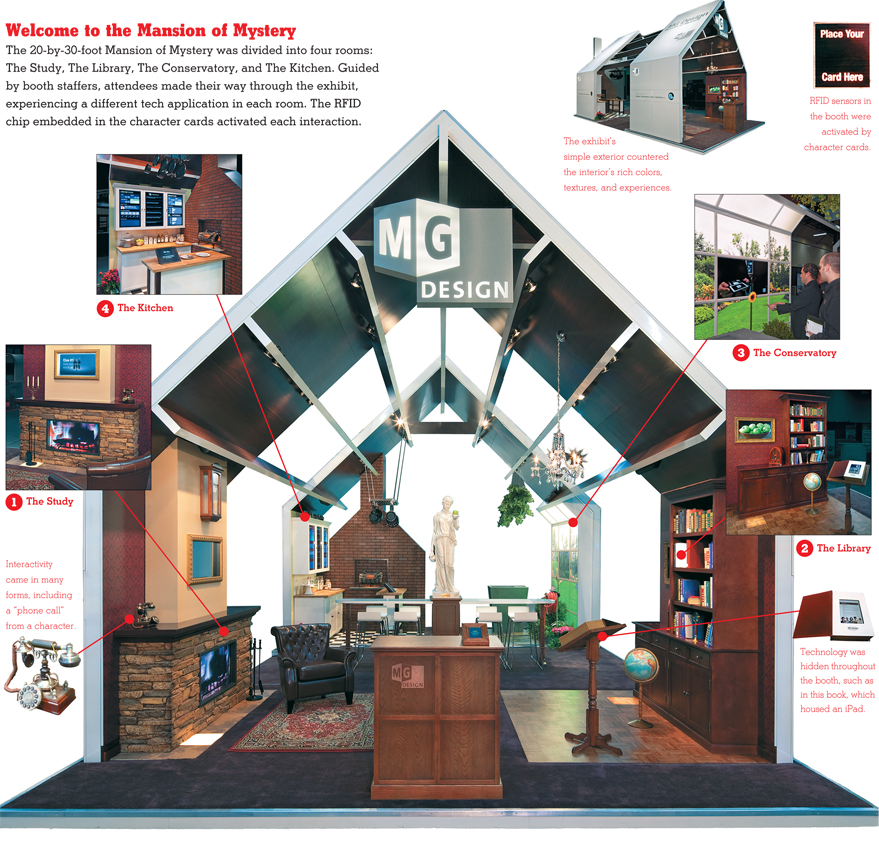 |
In addition to revealing the simple solution to the exhibit-marketing mystery, the monitors also displayed information about each attendee's visit to the booth, including how much time was spent in each room, the character card he or she used, and data culled from the survey. The monitors also displayed cumulative data, so attendees could compare their Mansion of Mystery experience to that of their peers'.
Mystery Solved
Like any good host, MG Design sent thank-you e-mails to every guest that visited the Mansion of Mystery. The thank yous featured an image of all five characters and links to MG Design's Twitter feed and LinkedIn page.
In addition to the e-mail, MG Design mailed post-show gifts to the 30 VIPs and top prospects and clients that visited the exhibit. Each gift arrived in a small box labeled with the MG Design logo and the text, "Thanks for visiting the MG Design Mansion of Mystery at EXHIBITOR2011!" Inside the box, recipients discovered a digital photo frame - a gift that paid homage to the many flatscreen monitors attendees encountered on their mansion tour.
From the pre-show mailers to the in-booth experience to the post-show follow-up, MG Design's Mansion of Mystery was cloaked in technology - and judges took note. "This comes from a really smart place strategically," one judge said. "MG Design identified a need exhibitors have, and it built an entire campaign around serving that need."
Furthermore, MG Design's Mansion of Mystery struck a chord with the show's attendees, who flocked to MG Design's Twitter feed after the show looking for continued inspiration, doubling the company's followers. And, to keep that conversation going, MG Design plans on issuing a newsletter called "eClues" (covering tech topics, case studies, and tips) to leads collected at the show.
When all was said and done, the benefits for attendees were obvious - but MG Design didn't walk away from the Mansion of Mystery empty-handed. In addition to the increased Twitter following, the integrated program also received mentions in various industry publications, including Exhibit City News, Exhibitors Daily, and Trade Show Expo. Plus, the company secured six RFPs as a result of the campaign - 33 percent over its original goal. Indeed, the uncontested success of the Mansion of Mystery conjures another "Clue"-inspired phrase: Case closed.E
|
|
|
|




 rofessor Plum, in the library, with the candlestick." Believe it or not, those eight words were the inspiration for MG Design Associates Corp.'s integrated program at EXHIBITOR2011, an educational conference and exhibition for exhibit and event marketers held at Mandalay Bay Convention Center in Las Vegas. Of course, most people associate the phrase with the classic board game, "Clue," which is set inside a nine-room mansion. The object of that popular game is to solve a murder using the powers of deduction. Players each select one of six characters to represent themselves and pitch suggestions throughout the game, proposing a suspect, a location, and a murder weapon by which the crime took place.
rofessor Plum, in the library, with the candlestick." Believe it or not, those eight words were the inspiration for MG Design Associates Corp.'s integrated program at EXHIBITOR2011, an educational conference and exhibition for exhibit and event marketers held at Mandalay Bay Convention Center in Las Vegas. Of course, most people associate the phrase with the classic board game, "Clue," which is set inside a nine-room mansion. The object of that popular game is to solve a murder using the powers of deduction. Players each select one of six characters to represent themselves and pitch suggestions throughout the game, proposing a suspect, a location, and a murder weapon by which the crime took place. 



